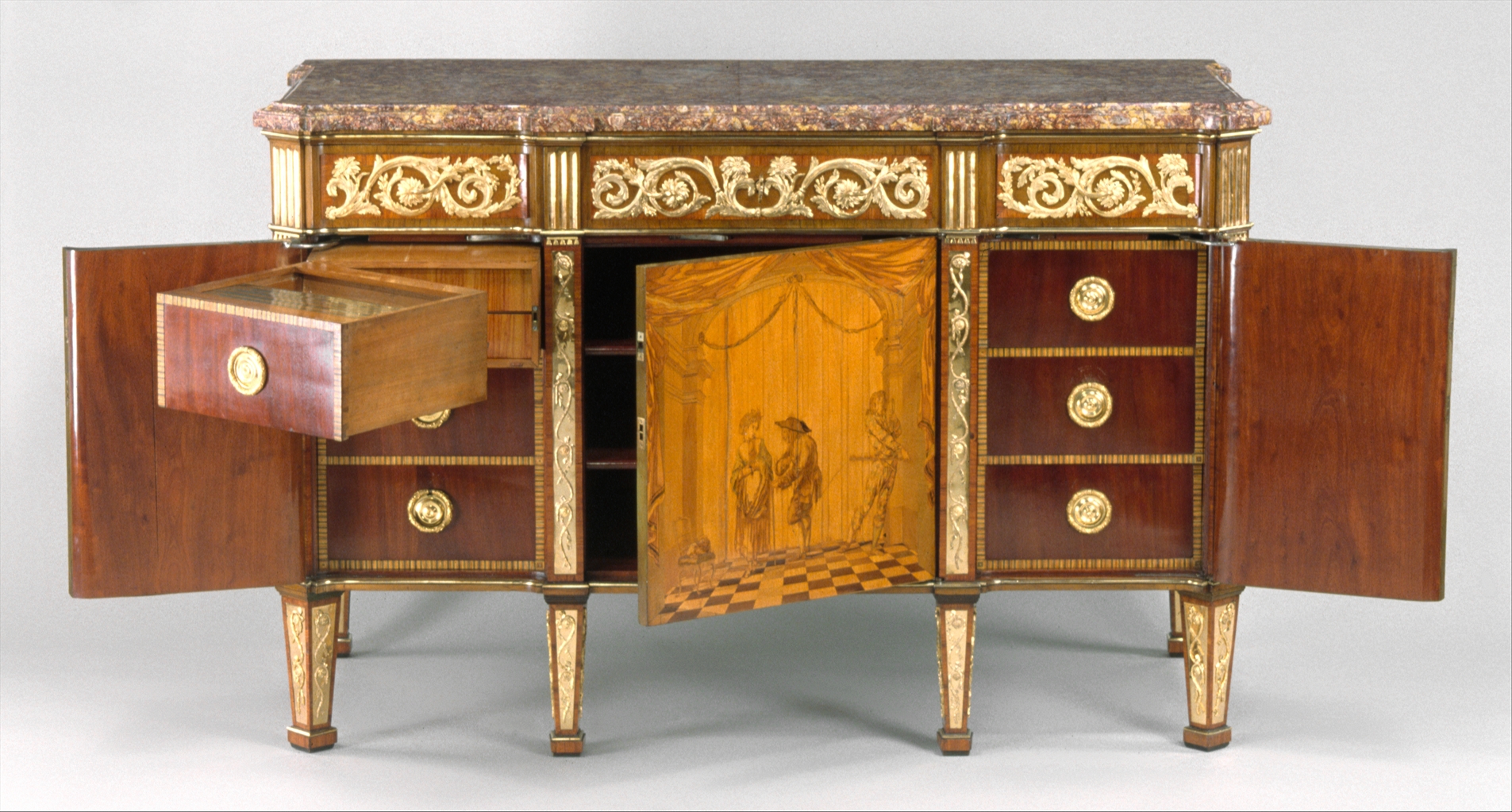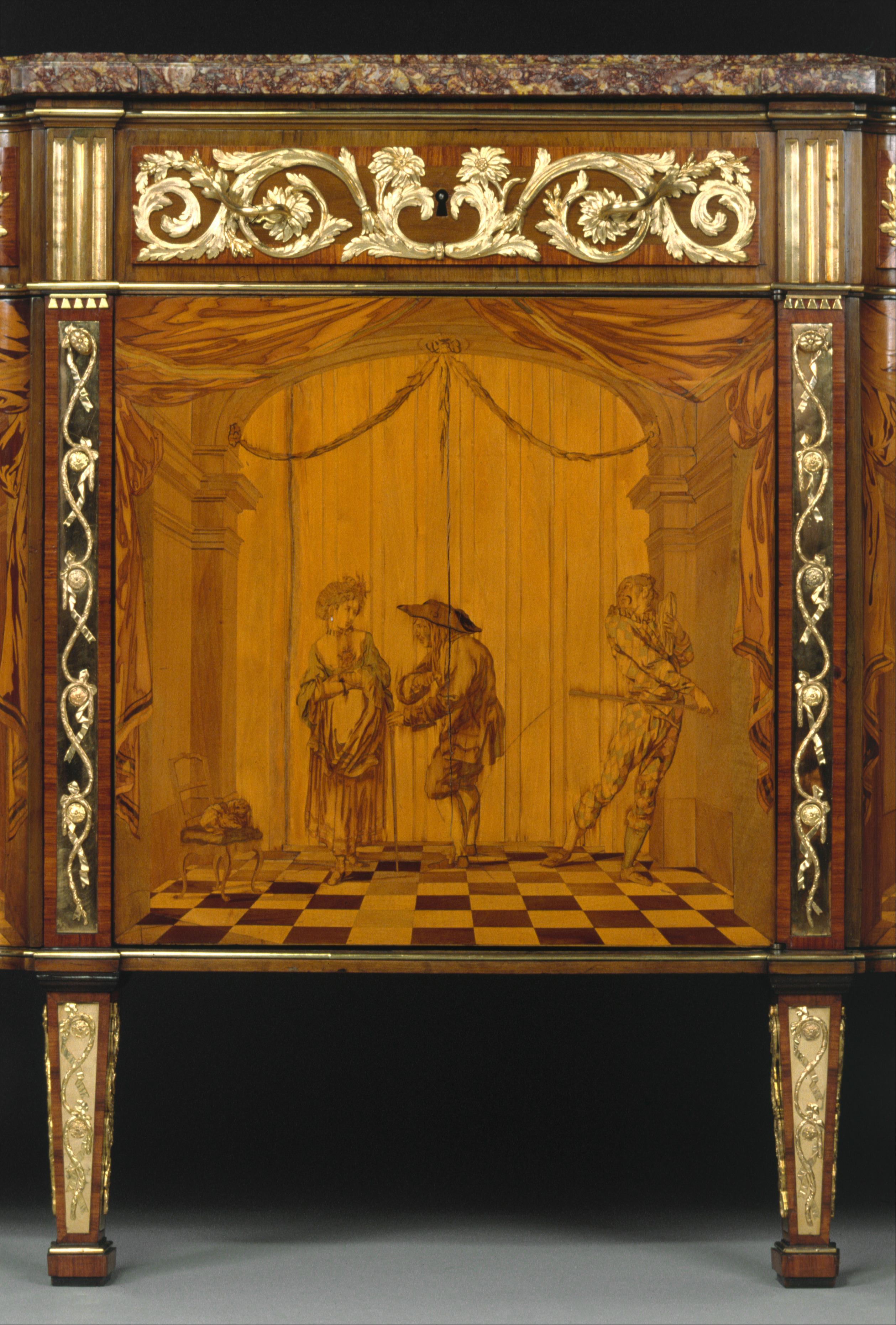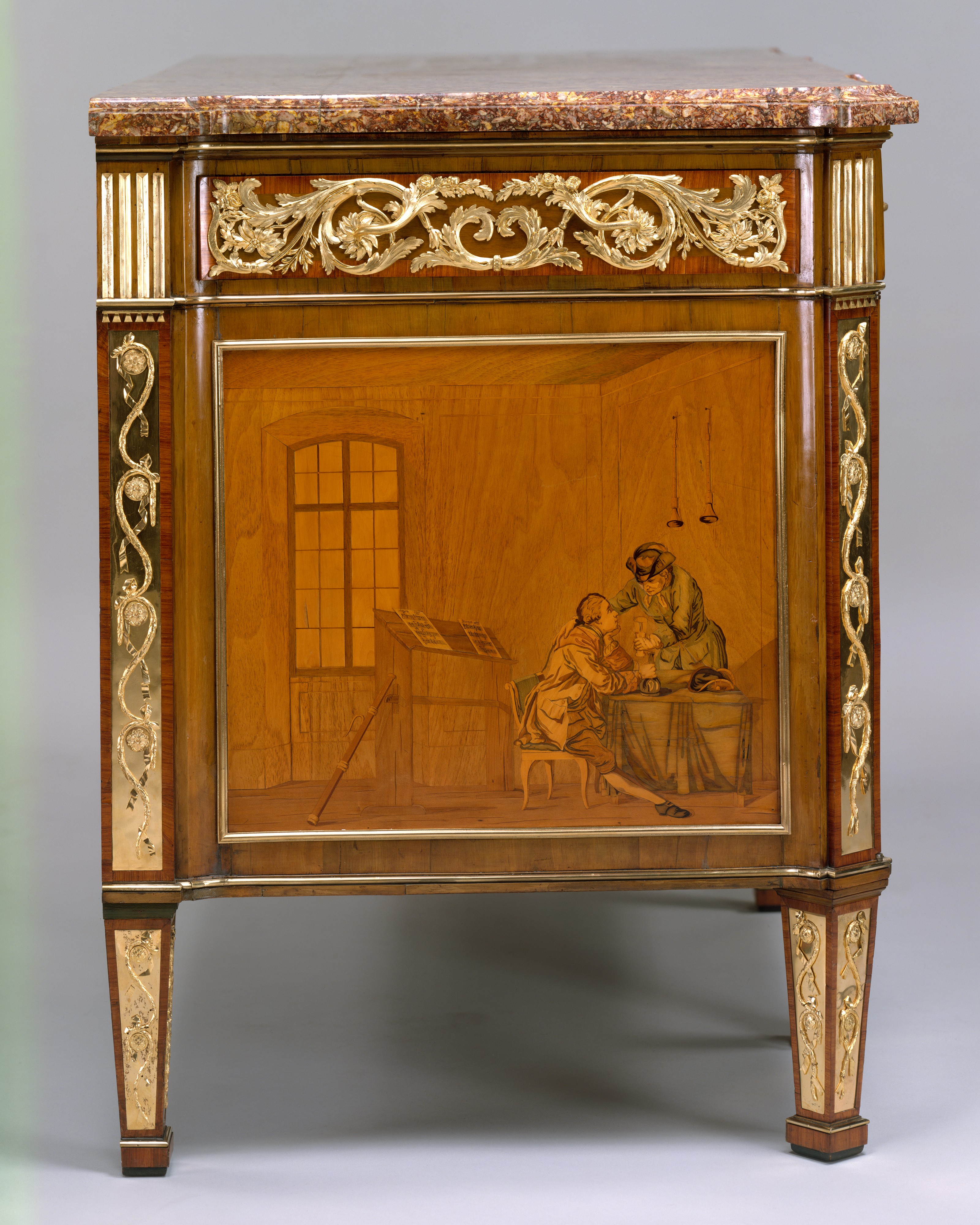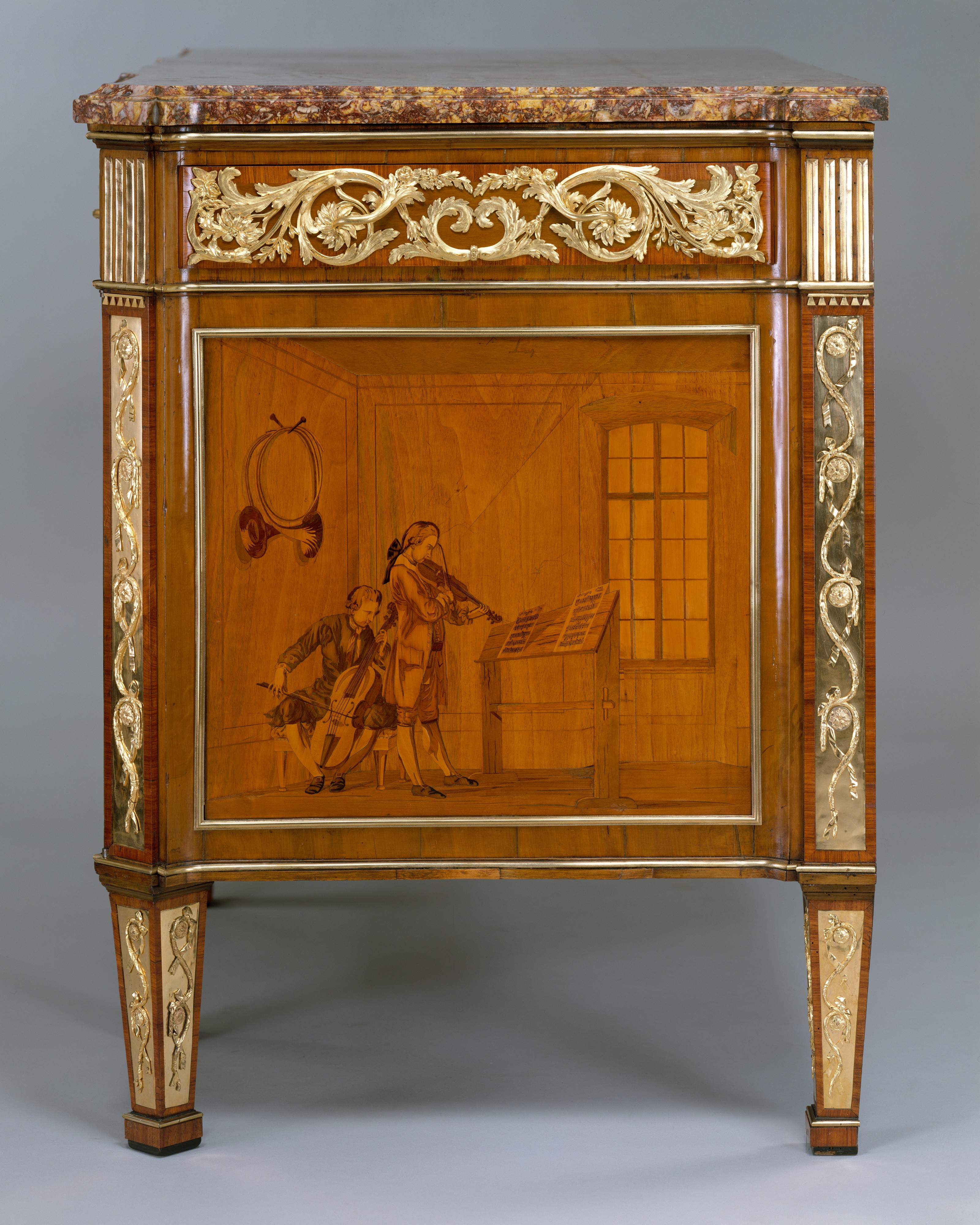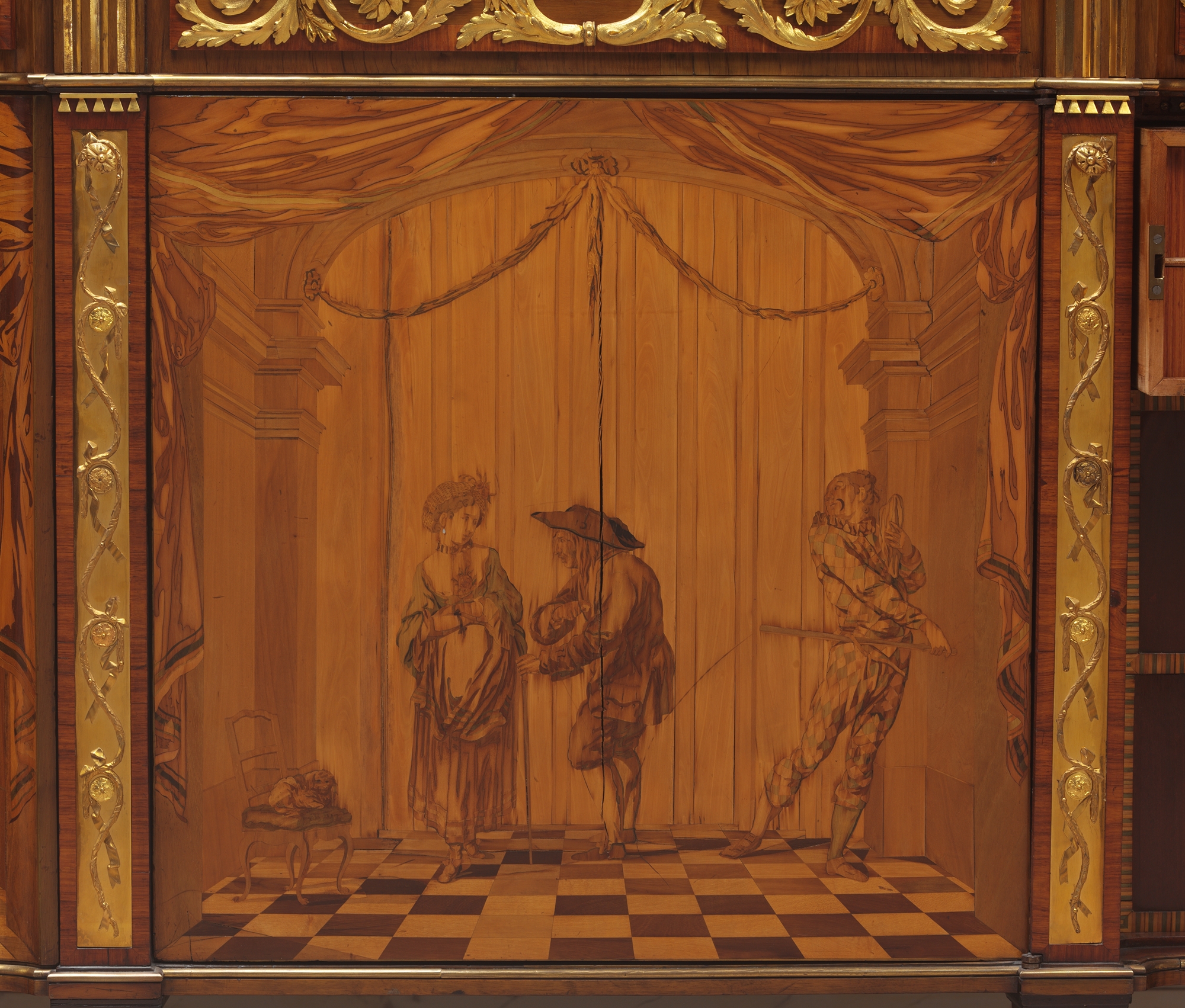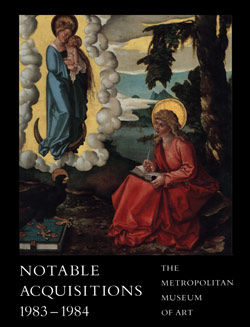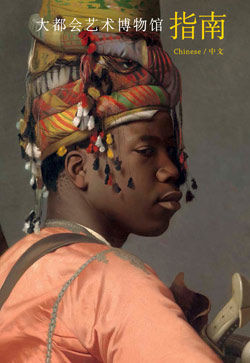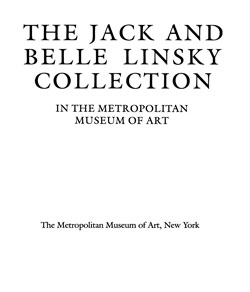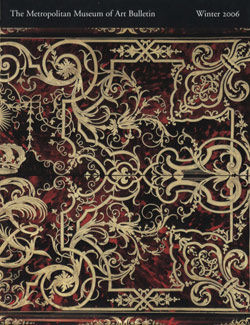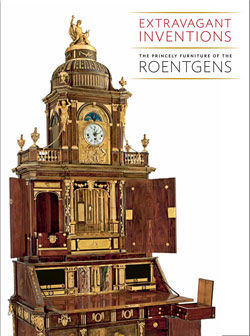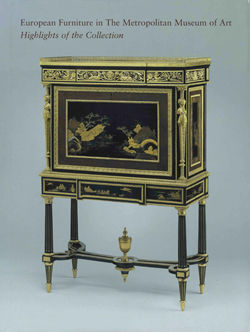Commode à vantaux
This important Roentgen commode, as well as another example in the Victoria and Albert Museum, London (W 51-1948), both have an illustrious provenance. Their histories may have begun in the royal apartments at Versailles. During the nineteenth century this example now at the Metropolitan Museum belonged to Baron Mayer de Rothschild, a member of the distinguished banking and art-collecting family, who kept it at Mentmore Towers, his palatial and splendidly appointed residence in Buckinghamshire. In 1964 it went under the hammer in London and fetched the highest price ever paid at auction for a piece of furniture, attracting tremendous media attention.[1]
The New York and London commodes are related closely to each other and to the latter’s nearly identical counterpart at the Bayerisches Nationalmuseum in Munich, with which it once formed a pair in the collection of the grand duke of Sachsen-Weimar.[2] All three pieces are so-called commodes à vantaux, which means they have three doors concealing interior drawers; however, they all include a shelf compartment, rather than drawers, behind the central door, which transforms the type into a combination of the commode à vantaux and a variation called commode en bas d’armoire.[3]
All three commodes have six feet. The feet of the New York commode, however, represent a unique departure in Roentgen’s oeuvre. Although the four outside feet are square as usual, the two front middle feet are trapezoidal and decorated with mounts on the three visible sides, lending an extra element of luxury. The fronts of the commodes are divided into three vertical sections, and the frieze contains a single drawer that runs the full width of each piece. The sides and the three front door panels are decorated with marquetry: the former show musicians—woodwind and stringed-instrument players—and the center panel on the front shows a scene of actors on a stage. In several ways, the marquetry of the New York commode differs from its two counterparts. It probably originally resembled the others closely, but major alterations were undertaken at some point after the French Revolution, when the taste of the ancient régime fell into disrepute. The absorbing story of how the New York commode was changed can be found in an appendix by Mechthild Baumeister in this volume. Suffice it here to mention four major differences: First, the two lateral doors on the front of the Metropolitan’s commode show two empty stages, whereas those doors on the London and Munich commodes display theater boxes filled with people watching the performance taking place in the scene on the central door. Second, the panels on the sides of all three pieces are the same, but those on the New York commode are reversed, with the woodwind players on the proper right side. Third, the frieze mounts on the New York commode are replacements of mounts similar to their counterparts and by another hand. The mounts on the feet and stiles are also different. Fourth, the original blue-gray marble tops preserved on the London and Munich commodes have been replaced on the Metropolitan’s by a red brocatelle marble slab. [4]
Inside the three commodes, the layout is similar, but the hidden mechanisms in the London and Munich examples are more sophisticated. The large frieze drawer, the doors, and the top interior drawers of the latter are opened by different actions of a single key in one keyhole, which is concealed by an ormolu rosette on the frieze drawer when not in use. The mechanism is weight- and spring-driven. On either side of the interior of the three commodes, the upper drawer can be swung sideways to access hidden compartments with secret drawers. The top of the front compartment lifts up on the London commode; it is covered with a tambour on the New York commode, giving access to a well.
The finest mounts on the London commode are Paris-made; Neuwied examples are used in less-prominent places. The duotone gilding and surface chasing of the box-tie handles on the drawers are of the highest level that the workshop of François Rémond produced. The similarly delicate frieze mounts were replaced on the New York commode with a bold scrolling ornament, probably the work of the Paris bronze caster Étienne Martincourt.
Januarius Zick, who frequently worked for David Roentgen, certainly designed the marquetry scenes on the front of the commodes as well as the ones on the sides, and undoubtedly Roentgen’s engraver Elie Gervais produced the line drawings for the marquetry cutters to work from. The central scene on the front features well-known characters from the Italian theatrical tradition known as the commedia dell’arte, which enjoyed a revival during the second half of the eighteenth century. Pictured are the clever servant Harlequin at right, his sweetheart, the lady’s maid, Columbine, in a flower-decorated straw hat on the left, and the aged Anselmo with a tricorne and walking stick in the center.[5] The scenes on the sides of the three commodes depict two musician in an airy room with an arched casement window: on one panel, a violinist and a cellist share a trestle stand with two sheets of music on it as they play. Brass horns hang on the wall. In the other panel, two woodwind players rest at a table. On the wall behind them are two oboes, and a bassoon leans against the music stand on which sheets of music are propped.
The New York commode is branded twice on the uprights of its paneled back with a double V beneath a crown, which is the inventory mark of Versailles. Although it is uncertain that the back panel is original to the piece, it is not impossible that the commode originated in the private apartments of Louis XVI. Indeed, records of the king’s expenditures mention the payment of 2,400 livres on April 11, 1779, "to the Germans for a big commode."[6] But in an inventory of 1792, the scenes on the sides of that same commode are said to depict Astronomy and the Arts, rather than musicians.[7] This may represent a misunderstanding on the part of an inventory taker who did not recognize the oboes as musical instruments and thought the bassoon was a telescope. Moreover, the inventory was almost certainly made in a hurry, for the furniture was to be removed from Versailles and sold in Paris for cash to support the Revolution. Specific woods, including their coloration, and small chased ornaments mentioned in the inventory are found on the New York commode and not the other two, yet it is surprising that no mention is made of the commedia dell’arte scene. Another inventory of Versailles furnishings, made in 1793, that documents a smaller commode owned by the comtesse d’Artois, the sister-in-law of Louis XVI, does mention the commedia dell’arte scene.[8] But the measurements given in the inventories for the two commodes make Louis XVI’s slightly larger example a better match with the New York commode.
[Wolfram Koeppe 2012]
Footnotes:
1. On the Rothschilds, see Georg Heuberger, ed. The Rothschilds. 2 vols. Exh. cat. Jewish Museum, Frankfurt; 1994–95. Sigmaringen, 1994. [Published in German as Die Rothschilds. Sigmaringen, 1994.] On the commode while it was at Mentmore, see Mentmore. 2 vols. Edinburgh, 1884, vol. 2, p. 187, no. 10, where it is described as in an upstairs gallery and as by David de Luneville (David Roentgen) and the Parisian mount maker Pierre Gouthière. Jack and Belle Linsky purchased the commode in 1964 for 63,000 pounds sterling ($176,000).
2. According to Hans Huth, the commode now in the Victoria and Albert Museum, London, and the very similar example now in the Bayerisches Nationalmuseum, Munich, were owned as a pair by the Grand Duke of Sachsen-Weimar; Hans Huth. Roentgen Furniture: Abraham and David Roentgen, European Cabinet-Makers. London, 1974, p. 46 [Also published in German as Abraham und David Roentgen und ihre Newuwieder Möbelwerkstatt. Munich, 1974]. See also Hans Huth. Abraham und David Roentgen und ihre Neuwieder Möbelwerkstatt. Deutscher Verein für Kunstwissenschaft. Berlin, 1928, p. 66, commentary on plate 40. One of the two was offered in the Sachsen-Weimar sale (Sotheby’s, London, June 10, 1932, lot 136), and the photographs reproduced in the accompanying catalogue are undoubtedly of the commode now at the Bayerisches Nationalmuseum. An annotated copy of the sale catalogue (archives of Sotheby’s London), however, clearly states that Lady Eckstein purchased the piece, which since 1948 has been in the collection of the Victoria and Albert Museum. Both museums believe that their commode is the one bought at that sale. A label preserved on the underside of the marble top of the London commode, "Weimar R Schloss 21," and a pencil inscription also on the underside of the marble, "Weimar 20," clearly refer to its Weimar provenance. Recent research by Dr. Gert-Dieter Ulferts and Christian Pönitz of the Klassik Stiftung Weimar did not reveal any further information about the history of the London and Munich commodes before the 1920s. In an e-mail of June 21, 2012, to Wolfram Koeppe, Gert-Dieter Ulferts mentioned that the label text and pencil inscription on the underside of the marble top of the London commode most likely refer to an inventory of the furniture in the Weimar residence (Residenzschloss Weimar) possibly made by the Hofmarschallamt in the 1920s and that the numbers 20 and 21 do not relate to a specific room in the castle. On the Bayerisches Nationalmuseum commode’s provenance, see Georg Himmelheber. "Roentgenmöbel in Münchner Museen. XI. Kommode, um 1779, Bayerisches Nationalmuseum." Weltkunst 61, no. 20 (October 15, 1991), pp. 3012–15.
3. Henry Havard. Dictionnaire de l'ameublement et de la décoration depuis le XVIIIe siècle jusqu'à nos jours. 4 vols. Paris, 1887–90, vol. 1, pl. 54, col. 937; John Fleming and Hugh Honour. The Penguin Dictionary of Decorative Arts. New ed. London and New York, 1989, p. 210.
4. In an e-mail of May 7, 2012, to Wolfram Koeppe, Ferdinand Heinz said that in David Roentgen’s time, the blue-gray marble called bleu turquin was also known as bardiglio di Carrara. He added that the quarries of true bardiglio marble are located in the Apuan Alps, at a few locations north and east of the town of Carrara, in Tuscany. Koeppe has suggested elsewhere that the bleu turquin slabs on the London and Munich commodes came from a quarry near Leun on the Lahn River, not far from Neuwied, which belonged to the counts of Wied or their relatives; see Wolfram Koeppe in Daniëlle Kisluk-Grosheide, Wolfram Koeppe, and William Rieder. European Furniture in The Metropolitan Museum of Art: Highlights of the Collection. New York, 2006, p. 181. Only a mineralogical analysis of the slabs will tell us exactly where the marble originated. The slab of red brocatelle marble on the New York commode comes from a Catalonian quarry near Tortosa; see Harald Mielsch. Buntmarmore aus Rom im Antikenmuseum Berlin. Staatliche Musseen Preussischer Kulturbesitz, Berlin, 1985, p. 42, pl. 5, nos. 165, 167.
5. For a summary of the subject as treated in eighteenth-century decorative arts, see Meredith Chilton. Harlequin Unmasked: The Commedia dell’Arte and Porcelain Sculpture. George R. Gardiner Museum of Ceramic Art, Toronto. New Haven, 2001, and see p. 150 for a discussion of Anselmo with a cocked hat and cane. For Zick see Othmar Metzger. "Januarius Zicks Entwürfe für Intarsien David Roentgens." Pantheon 39, no. 2 (April–June 1981), pp. 176–79; Josef Strasser. Januarius Zick, 1730–1797: Gemälde, Graphik, Fresken. Weissenhorn, 1994; Daniëlle O. Kisluk-Grosheide. "Versailles au Metropolitan Museum de New York." Versalia, no. 8 (2005), p. 88.
6. "aux allemands pour une grande commode L 2400"; Comte R. de Beauchamp. Comptes de Louis XVI. Paris, 1909, p. 71 (cited in Christian Baulez. "David Roentgen et François Rémond: Une collaboration majeure dans l’histoire du mobilier européen." L’estampille/L’objet d’art, no. 305 (September 1996), p. 101); Dietrich Fabian. Abraham und David Roentgen: Das noch aufgefundene Gesamtwerk ihrer Möbel- und Uhrenkunst in Verbindung mit der Uhrmacherfamilie Kinzing in Neuwied. Leben und Werk, Verzeichnis der Werke, Quellen. Bad Neustadt an der Saale, 1996, p. 347, doc. no. 2.171 [translated from the French]).
7. Following is the full text of the 1792 Versailles inventory and the English translation.
Une Commode mechanique en bois de Placage dites des allemants la ditte Commode ouvrante a trois Vanteaux par Différent Mouvement le dedans Composé D’un Mechanisme particulier dont le Roi a la clef [.] lextérieur [sic] de la commode plaque a tableaux de bois fond Satiné et ombré Sur les trois faces deux Medaillons et Un tableau Sur le devant 1 tableau de chaque côtée Representant, l’astronomie et arts en figures de bois de Rapports ombrés au feu, les champs des paneaux en bois Satiné Vert Ceux des pieds et pilastres en bois Rose, les pieds a guaisnes Carré le tout orné de bronze Savoir les frises pilastres et les corp des pieds a tables Saillantes dans les frises Renfoncé et ciselés dans les pilastres avec de petits ornements Saillants Ciselés les Medaillons du devant Entouré d’un cadre a perles les portants de tiroirs en paquets de lauriers le tout De bronze doré or Moulüe et Moulures Idem Canelures etc, le Marbre du dessus en bleu turquin; 4 pieds 2 pouces de large 25 pouces de profondeur et 2 pieds 9 pouces de haut, Marbre Compris. (A mechanical commode veneered said from the Germans the said commode opening with three doors by different movements the interior composed of a special mechanism for which the king has the key [.] The exterior of the commode veneered with [marquetry] panels of bois satiné ground and shaded on the three sides two medallions and one [marquetry] panel on the front 1 [marquetry] panel on each side representing, Astronomy and the Arts, figures in various pieces of wood shaded by burning, the fields of the panels in green bois satiné. Those of the feet and pilasters in tulipwood, the square tapering feet the whole decorated with bronze to wit the friezes pilasters and the body of the feet with plates projecting in the friezes recessed and chased in the pilasters with small chased ornaments in relief of the medallions on the front surrounded with a beaded frame the handles of the drawers in sprays of laurel the whole of gilt-bronze ormolu and moldings idem fluting etc, the marble top bleu turquin; 4 pieds 2 pouces wide 25 pouces deep and 2 pieds 9 pouces high, marble included).
Archives Nationales, Paris, O1 3426, Versailles, Recépissés des Meubles envoyés à Paris, Le 5. Jer. [janvier] 1792. The passage is also cited, in updated French in Christian Baulez. "David Roentgen et François Rémond: Une collaboration majeure dans l’histoire du mobilier européen." L’estampille/L’objet d’art, no. 305 (September 1996), pp. 101–2, and Daniëlle O. Kisluk-Grosheide. "Versailles au Metropolitan Museum de New York." Versalia, no. 8 (2005), p. 87. We thank Ulrich Leben and Bertrand Rondot for photographing and assisting us in interpreting the original text.
8. Following is the English translation of the 1793 Versailles inventory quoted in Christian Baulez. "David Roentgen et François Rémond: Une collaboration majeure dans l’histoire du mobilier européen." L’estampille/L’objet d’art, no. 305 (September 1996), p. 108 and Daniëlle O. Kisluk-Grosheide. "Versailles au Metropolitan Museum de New York." Versalia, no. 8 (2005), p. 88: "a veneered commode with three doors with human figures enacting comedy scenes as well as on the sides, with three drawers in the pareclose, covered with millesraies plates, garlands forming handles and laurel leaves, the whole in matte gilt-bronze and with beaded frame, with bleu turquin marble top, 2 pieds 8 pouces high, 4 pieds wide, and 2 pieds deep (estimated) 4,000 livres."
9. Before the introduction of the metric system in 1799, French units of measurement were organized in much the same way as the British Imperial System. The pied (foot), or pied du roi (king’s foot), equaled 32.48 centimeters, and the pouce (thumb, equivalent to the inch) measured 2.71 centimeters. Accordingly, the dimensions of Louis XVI’s commode given in the 1792 inventory would translate to 89.35 centimeters high (including the marble top), 135.34 centimeters wide, and 67.75 centimeters deep. The dimensions of the comtesse d’Artois’ commode given in the 1793 inventory would translate to 86.64 centimeters high, 129.92 centimeters wide, and 64.9 centimeters deep. The Metropolitan Museum’s commode is 89.5 centimeters high, 135.9 centimeters wide, and 69.2 centers deep (including the later red brocatelle marble top), and 86.5 centimeters high, 135.6 centimeters wide, and 66.8 centimeters deep without the marble top. It should be borne in mind, however, that until 1799 no single consistent system of measures was used in France, so these calculations must be viewed with caution.
Due to rights restrictions, this image cannot be enlarged, viewed at full screen, or downloaded.
This artwork is meant to be viewed from right to left. Scroll left to view more.


